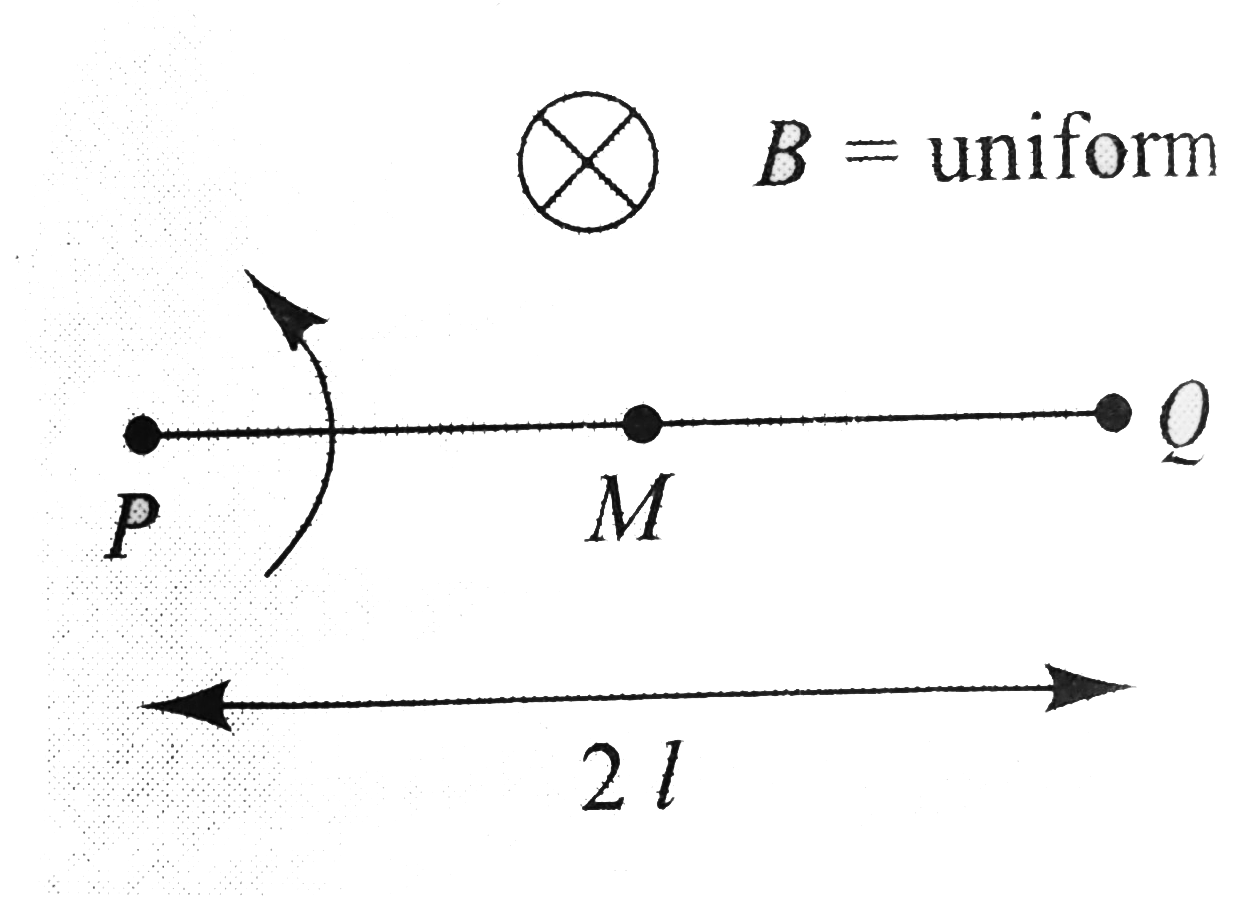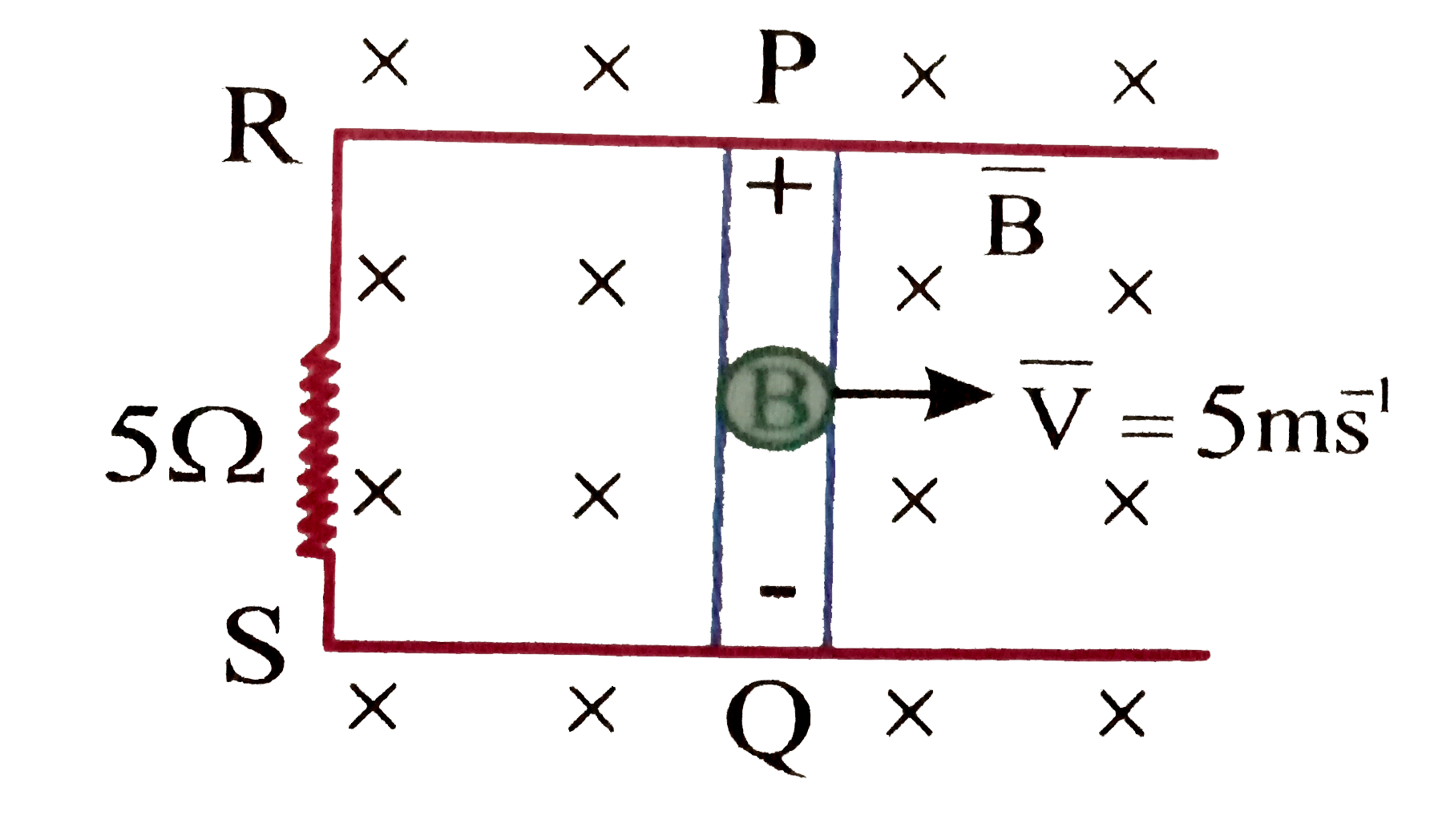A conducting rod AB moves parallel to x-axis in a uniform magnetic field pointing perpendicular and into the plane of paper. The end A of the rod

gets positively charged
gets negatively charged
remains neutral
gets positively charged first and then negatively charged
When rod moves, its free electrons constitute a current along the negative y-axis. According to Fleming.s left hand rule, the force on electrons is along the length towards B, so electrons migrate from A to B, and hence end A becomes positively charged.

Topper's Solved these Questions
- ELECTROMAGNETIC INDUCTION Book:CENGAGE PHYSICSChapter:ELECTROMAGNETIC INDUCTION Exercise:OLYMPIAD AND NTSE LEVEL EXERCISES
Explore 10 Videos
- ELECTROMAGNETIC INDUCTION Book:CENGAGE PHYSICSChapter:ELECTROMAGNETIC INDUCTION Exercise:MANDATORY EXERCISE (EXERCISE SET IV)
Explore 1 Video
- CURRENT ELECTRICITYBook:CENGAGE PHYSICSChapter:CURRENT ELECTRICITYExercise:OLYMPIAD AND NTSE LEVEL EXERCISES
Explore 10 Videos
- ELECTROMAGNETIC SPECTRUM AND RADIATIONSBook:CENGAGE PHYSICSChapter:ELECTROMAGNETIC SPECTRUM AND RADIATIONSExercise:Olympiad And NTSE Level Exercises
Explore 10 Videos
Similar Questions
A conducting rod AB moves parallel to the x-axis (see Fig.) in a uniform magnetic field pointing in the positive z-direction. The end A of the rod gets positively charged.
 .
.
View SolutionA conducting rod AC of length 4l is rotated about point O in a uniform magnetic field →B directed into the plane of the paper. AO=landOC=3l. Find VA−VC.

View Solution
Knowledge Check
A conductor rod AB moves parallel to X-axis in a uniform magnetic field, pointing in the positive Z-direction. The end A of the rod gets-
 Apositively chargedBnegatively chargedCneutralDfirst positively charged and then negatively charged.
Apositively chargedBnegatively chargedCneutralDfirst positively charged and then negatively charged.A conducting rod AB moves parallel to x-axis in the x-y plane. A uniform magnetic field B pointing normally out of the plane exists throughout the region. A force F acts perpendicular to the rod, so that the rod moves with uniform velocity v. The force F is given by (neglect resistance of all the wires)
 AvB2l2Re−t/RCBvB2l2RCvB2l2R(1−e−t/RC)DvB2l2R(1−e−2t/RC)
AvB2l2Re−t/RCBvB2l2RCvB2l2R(1−e−t/RC)DvB2l2R(1−e−2t/RC)The counductor AD moves to the right in a uniform magnetic field directed into the plane of the paper.
 A(a) The free electron in AD will move toward AB(b) D will acquire a positive potential with respect to AC(c ) A current will flow from A→D in AD in closed loopD(d) The current in AD flows from lower to higher potential
A(a) The free electron in AD will move toward AB(b) D will acquire a positive potential with respect to AC(c ) A current will flow from A→D in AD in closed loopD(d) The current in AD flows from lower to higher potential
Rod PQ of length 2l is rotating about one end P in a uniform magnetic field B which is perpendicular to the plane of rotation of the rod . Point M is the mid- point of the rod. Find the induced emf between M and Q if the potential between P and Q is 100V.

View SolutionFigure shows a conducting rod PQ in contact with metal rails RP and SQ, which are 0.25m apart in a uniform magnetic field of flux density 0.4T acting perpendicular to the plane of the paper. Ends R and S are connected through a 5Ω resistance. What is the emf when the rod moves to the right with a velocity of 5ms−1 ? What is the magnitude and direction of the current through the 5Ω resistance? If the rod PQ moves to the left with the same speed, what will be the new current and its direction?

View SolutionA rod AB moves with a uniform velocity v in a uniform magnetic field as shown in figure.

View SolutionA uniform but time varying magnetic field is present in a circular region of radius R. The magnetic field is perpendicular and into the plane of the loop and the magnitude of field is increasing at a constant rate α. There is a straight conducting rod of length 2R placed as shown in figure.

The magnitude of induced emf across the rod is
View SolutionAssertion: A metal rod is moved perpendicular to the length of rod and uniform magnetic field exits perpendicular to the plane of motion of rod. Electric field is generated along the length of the rod.
Reason: When metallic object moves inside magnetic field then free electrons experience force and are moved in the direction of force. Due to redistribution of electrons, electric field is created in the metal.
View Solution

